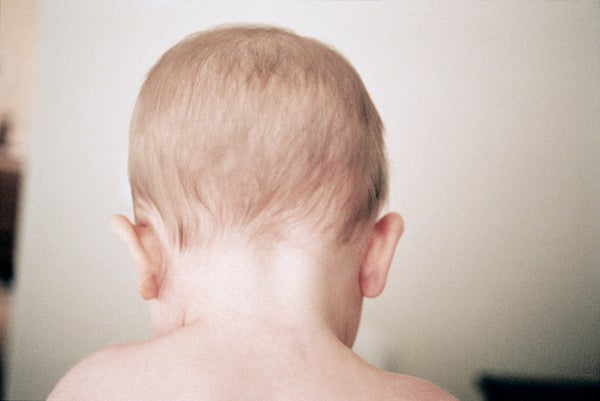Pain in infants is heartbreaking for new parents, and extremely difficult to treat effectively—if at all. Every year an estimated 15 million babies are born prematurely, most of whom will then undergo numerous lifesaving but painful procedures, such as heel pricking or insertion of a thin tube known as a cannula to deliver fluids or medicine. Preterm babies in the intensive care unit are subjected to an average of 11 such “skin-breaking” procedures per day, but analgesia is only used just over one third of the time.
We know that repetitive, painful procedures in early infancy can impact brain development negatively—so why is pain in infants so undertreated? One reason is the lack of standard guidelines for administering the drugs. Some analgesics given to adults are unsuitable for infants, and those that can be used often have different effects in children, making dosing a problem.
What is more, newborn babies are incapable of telling us how they feel, making it impossible to determine how effective any painkiller might be. Researchers at the University of Oxford may now have overcome this latter challenge, however. They report May 3 in Science Translational Medicine having identified a pain-related brain wave signal that responds toanalgesics, and could be used to measure the drugs’ efficacy.
On supporting science journalism
If you're enjoying this article, consider supporting our award-winning journalism by subscribing. By purchasing a subscription you are helping to ensure the future of impactful stories about the discoveries and ideas shaping our world today.
Until as recently as the 1980s, it was assumed that newborn babies do not feel pain, and that giving them analgesics would do more harm than good. Although these misconceptions have been cleared up, we still have very little understanding of infant pain, and so treating it is a huge challenge for clinicians.
In 2015 Oxford pediatric neuroscientist Rebeccah Slater and her colleagues published a pioneering functional magnetic resonance imaging (fMRI) study showing infants’ brains respond to painful stimuli very similarly to those of adults. The results suggested newborn babies not only experience pain in the same way as adults, they are in fact far more sensitive to it. The findings also highlight an urgent need for better ways of controlling infant pain.
In the new study the researchers used electroencephalography (EEG) to record the brain wave patterns of 18 healthy, full-terminfants exposed to painful and painless stimuli. They performed the heel prick procedure on the babies, which is used routinely to obtain blood samples, and applied low-intensity forces to the surfaces of their feet, a mildly painful experimental procedure that feels a bit like being gently poked with a blunt pencil. They also flashed lights into their tiny participants’ eyes, played them single tones from an mp3 player attached to a pair of speakers and touched their feet gently.
The team found the painful and painless procedures produced markedly different brain-wave patterns. Both of the painful procedures, but not the other stimuli, elicited an identically large response, detectable by an electrode placed at the top of the head approximately half a second later. The same kind of tests performed on 14 other healthy infants, combined with heart rate measurements, confirmed this signal was specific for the painful stimuli, and did not occur because of differences in physiological arousal.
Slater and her colleagues observed the same pain-related activity in 12 preterm infants in response to heel pricking, even in the absence of grimacing, one of the traditional behavioral measures of infant pain, but failed to detect it when the babies’ feet were anesthetized. “We can now objectively measure pain-related brain activity and determine whether different pain-relieving drugs effectively reduce pain during essential medical procedures,” Slater says. “We can also see how other interventions such as gently stroking the baby changes pain-related brain activity or whether different experiences such as a vaginal birth or C-section alters pain sensitivity in the newborn infant.”
Bonnie Stevens, a senior scientist at The Hospital for Sick Children at the University of Toronto and specialist in assessment and management of infant pain, commented after reading the study. “The initial results are promising,” although she adds several caveats: “The sample sizes are small, and the period of observation of EEG response is short and may not correlate well with behavior. But in spite of these issues there was a good indication of the specificity and sensitivity of the responses.” She notes the cost and expertise required for the application of EEG measures of pain for research or clinical use might be prohibitive. “We need to keep refining our approach to [pain] measurement, and it will likely take a broad constellation of measures to be accurate.”
Slater stresses the team did not develop the EEG measurements to assess pain in individual infants but hopes they will be useful for others working with newborns in clinical trials and research investigations. “We are now using these measures in the Procedural Pain in Premature Infants (Poppi) trial to test whether [they] can provide effective pain relief for prematurely born babies during invasive medical procedures,” she says. “Morphine is frequently given to adults when they experience pain, but it is not clear whether it provides effective pain relief in babies.”
Slater adds, “We will test whether babies who are given morphine experience less pain, and whether reducing pain during a painful eye exam improves stability of the heartbeat and breathing after the procedure.”
